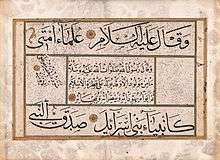Suyolcuzade Mustafa Eyyubi
Suyolcuzade Mustafa Eyyubi (1619?, Istanbul - 1686) was a 17th-century Ottoman calligrapher.
Life and work
Suyolcuzade Mustafa Eyyubi was born in the Eyiib district of Istanbul in around 1619. He was the son of Suyolcu Ömer Ağa.[1]
Initially, he studied calligraphy with Dede, who was very elderly at the time, and known as the "grandfather". Following the master's death, Eyyubi studied with Derviş Ali.[2]
Some of his best known students are Cabizade Abdullah, Hâfiz Osman and Hocazade Mehmed.[3][4]
Few of his works have survived. From about fifty Qur'an and 100 An'am-i Sharif written by him, just a few are available today.[5] He also produced 100 en'am and various qit'at. [6] Some of the surviving works are held in the Topkapi Collection.[7]
He died in 1686 in and was buried in the Kabristani in the Hamamarkası at Eyüp, but the location of his tomb is not known. The grave inscriptions were written by his grandson, Suyolcuzâde Mehmed Necib (d. 1757), who was also a calligrapher. [8] His grandson, Suyolcuzâde Mehmed Necib, wrote the Devḥatü l-küttāb, [translated as Genealogy of the Scribes or the Great Tree of Penmen] a compilation of biographies of famous calligraphers.[9]
See also
References
- ↑ Islamic Encyclopedia, Online:
- ↑ Kemal Çiçek, Ercüment Kuran, Nejat Göyünç, İlber Ortaylı, The Great Ottoman-Turkish Civilisation, Volume 3, Yeni Türkiye, 2000, n.p.; Islamic Encyclopedia, Online:
- ↑ M. Uğur Derman (2004). Masterpieces of Ottoman Calligraphy from the Sakıp Sabancı Museum. İstanbul: Sabancı Üniversitesi. pp. 82–83. ISBN 978-975-8362-45-5.
- ↑ Kemal Çiçek, Ercüment Kuran, Nejat Göyünç, İlber Ortaylı, The Great Ottoman-Turkish Civilisation, Volume 3, Yeni Türkiye, 2000, n.p.
- ↑ Karadaş, Celalettin. «Suyolcuzade Mustafa Eyyubi'nin Mushafı». Güzel Sanatlar Enstitüsü Dergisi (Erzurum: Atatürk Üniversitesi) 21 (2008): 113-121.
- ↑ Pickthall, M. W. and Asad, M., Islamic Culture, Volume 57, Islamic Culture Board, 1983, p. 20
- ↑ The Diez Albums: Contexts and Contents, BRILL, c. 2016, p.136
- ↑ Islamic Encyclopedia, Online:
- ↑ Islamic Encyclopedia, [http://www.islamansiklopedisi.info/dia/ayrmetin.php?idno=380002 Online (in Turkish); Behrens-Abouseif, D. and Vernoit, S., Islamic Art in the 19th Century: Tradition, Innovation, And Eclecticism, BRILL, 2006, p.90-93; Bayani, M., The Decorated Word: Qurʼans of the 17th to 19th Centuries, Volume 4, Part 1, Nour Foundation, 1999, p.66; Akin-Kivanc, E., Mustafa Âli's Epic Deeds of Artists: A Critical Edition of the Earliest Ottoman Text about the Calligraphers and Painters of the Islamic World, BRILL, 2011, p.10.
